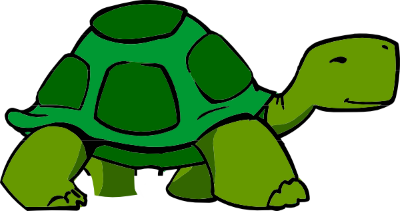Turtles -- School-Age
Turtles
Things to Know
A turtle is a reptile that has a shell covering its body. Several different scientific names are used for turtles including chelonia and testudines. Like other reptiles turtles are cold blooded. Turtles are known for moving slow.
Turtles are found in most parts of the world. Turtles do not live in Antarcitca or the Arctic Ocean. Most live in freshwater ponds, lakes, or rivers. Others live in the oceans or on land. Some turtles live in the desert or forests.
Reptiles
The chelonia order of reptiles includes turtles, tortoises and terrapins. The difference between the three has to do with where they live than how they look. Use of the three terms varies in different parts of the world.
Turtles
In the United States turtle describes chelonians that live in the water (aquatic), such as sea turtles that rarely comes up onto land except to lay eggs. Other types of turtles are semi-aquatic living in freshwater, ponds, and lakes, they live in the water but also spend time on land.
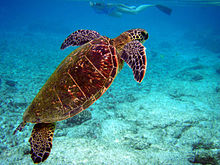
Green Sea Turtle
In Europe only sea turtles are called turtles. Freshwater turtles are called terripins and land based ones are called tortoises.
In Australia almost all turtles, except sea turtles, are called tortoises.
Turtles have legs with webbed feet and often have long claws. Sea turtles have flippers.
Tortoises
In North America, tortoises live on land. They have stubby feet and are not good swimmers. They will enter water to clean themselves or get a drink. The shells of tortoises are high domed shaped.
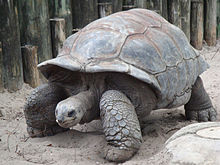
Aldabra Giant Tortoise
Terrapins
Terrapins are also called diamondbacks because of the diamond-shaped markings on their upper shells (carapaces). They live near brackish waters or swamps. They are usually small and have hard shells that are shaped between the tortoise's dome one and the turtle's streamlined one.
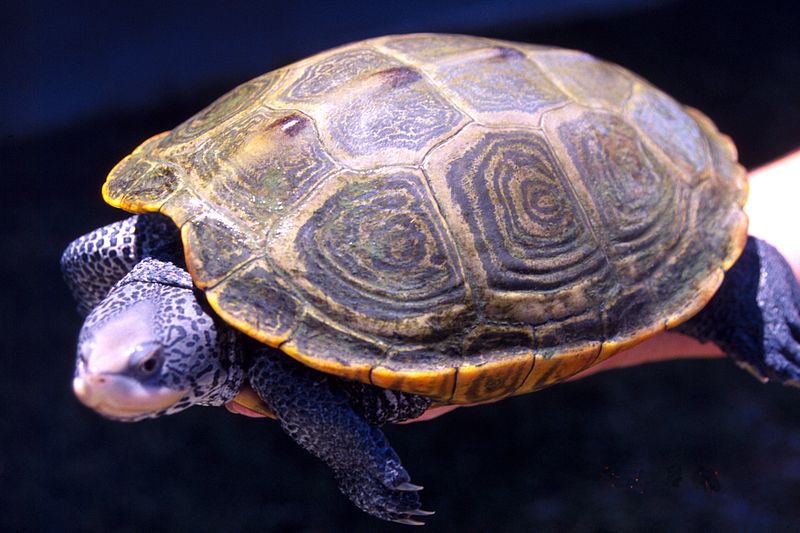
Diamondback
Turtle
Turtle Diet
Some turtle species are herbivore, carnivore, or omnivore. Most tortoises are herbivores. Their diet is plants. Most aquatic turtles are carnivores with a diet that contains 65 to 90% meat and 10 to 35% vegetables. Semi-aquatic turtles are omnivores with a diet that is 50% meat and 50% vegetables. Freshwater turtles may eat plants, insects, and small fish.
Turtle Eggs
All turtles lay eggs on land. They dig a nest in the groung. The female turtle will dig a nest with her hind legs. When the nest is just right the female turtle will lay the eggs. Some turtles lay one to two eggs, and some lay dozens of eggs at a time. The turtle will cover her eggs with sand and then leave. Most turtles leave the nest. Some female turtles have been seen guarding the nest to keep the eggs safe from snakes. When young tutles hatch the hatchlings are on their own.
Turtle Shells
Turtles have a hard shell that protects them from predators and environmenal conditions. Many turtles when frightened can hide their heads, tails, and limbs inside their shells.
Turtle shells are make of two parts: the carapace and the plastron. The carapace is the upper part of the the shell that covers the turtle's back. The plastron is the lower shell that covers the turtle's belly. At the sides of the turtle is a bony bridge that fastens the two together. Many turtle species can hide their heads, tail, and limbs in their shell, a hinge allows the carapce and plastron to close tightly and joins the two halves together.
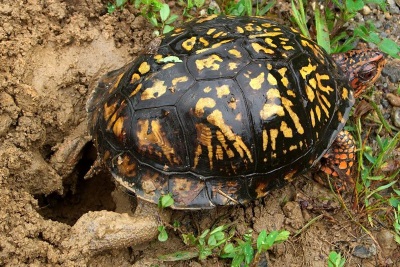

Carapace-upper shell
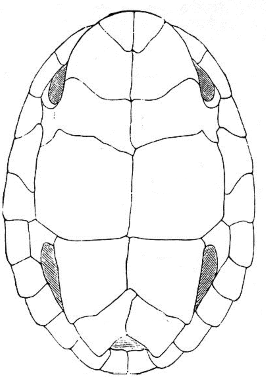
Plastron-lower shell
The turtle's shell is part of its spine. The top part of the shell, the carapace, is made from actual back bones and ribs. The hard bone plates are covered by fused scutes. The scutes are made of keratin a primary substance found in skin, hair, nails, hooves, horns, and teeth.
Some turtles do not have scutes and are called softshell turtles. They have a flattened shell and long necks. Their heads have snouts with nostrils at the tips. They often lie buried in mud, sand, and shallow water. They can breathe by extending their head and neck so that the snout is above the surface to breathe.
Softshell Turtle

